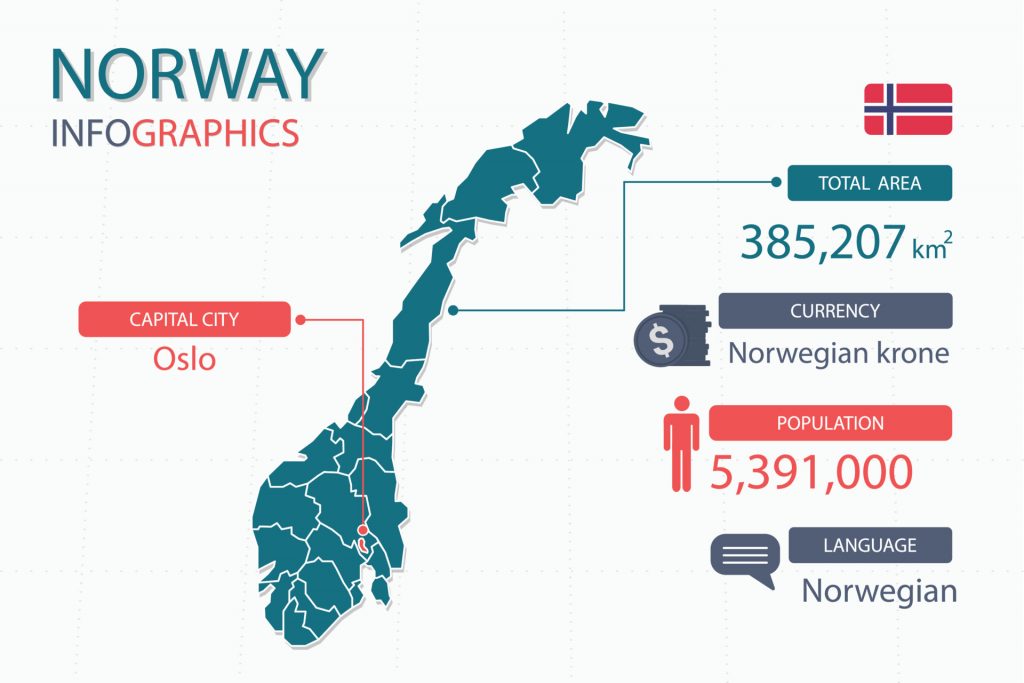The origins of the Norwegian Language
Norwegian is the official language of Norway as well as holding official status in the Nordic Council. It is closely related to the other Scandinavian languages including Swedish and Danish, where linguists describe it as being part of a dialect continuum between the two. Thus, people who speak Swedish and Danish can understand Norwegian under certain circumstances, depending on the accent or dialect of Norwegian that is being employed. About 5 million people speak it as a native language, and these speakers mostly reside in Norway. However, there are communities of speakers in a variety of other countries, including the United States, England, Australia, parts of South and Central America, and other parts of Europe.
A unique characteristic of Norwegian is its partitioning into two official written forms – one is called Bokmål and literally means “book tongue,” while the other is called Nynorsk which means new Norwegian. This partitioning is codified in law and is highly regulated by the Norwegian administration. The regulation is officially the responsibility of the Norwegian Language Council. Both these official standards provide conventions for written Norwegian, but there are no guidelines for an official spoken language. In the case of vernacular Norwegian, most speakers use the dialect they were raised with. This aspect differentiates Norwegian from other languages because grammatically correct spoken Norwegian has almost no relationship with correct written Norwegian. In fact, a truly grammatical correct spoken Norwegian does not really exist because of the number of dialects.

Norwegian is written using the Latin alphabet and contains 29 letters. There are additional letters that represent Norwegian sounds. The Norwegian alphabet is very similar to the Danish one due to their common history. There are also accent marks on top of some vowels that change the sound of the letters. Like many languages that use the Latin alphabet, it is written from left-to-right and contains common punctuation like the full stop, the comma, and the question mark. As stated above, there are two official written formal conventions, however, there is also an official one called Riksmål, literally meaning “national language.” Such a complicated situation is the reason for a lack of a truly standardized spelling, but the spelling used depends on the register being employed.
Norwegian and Danish share a very close history. Both stem from Old East Norse, a language that existed before Norwegian and Danish were considered separate languages. This language was written using the Runic alphabet. However, there were minor differences between the dialects of each region. In the 11th century, Christianity arrived into Scandinavian lands and brought the prestige of the Latin script, which eventually replaced the older Runic scripts.
The Bible was eventually translated into Danish during the middle ages. Norway and Denmark formed a union in 1397. At this point, Danish became a language of prestige in Norwegian lands, especially in regards to law, administration, religion, and literary culture. However, this union ended, in 1814 and it was at this time that Norwegian speakers began to diverge even more from Danish to a point where the Norwegian language had emerged. Since the 16th century, Danish had always been the standard written language, and thus many linguists and writers in the 19th century tried to advocate for a Norwegian national language so that Norwegians too can have a prestige literary tradition. Most notably, Ivar Aasen traveled to the rural areas of Norway to codify language that had not descended directly from Danish; he considered speakers of these areas to use purer Norwegian because they were not as influenced by the Danish-speaking elite.
As a result of this, the two varieties of Norwegian mentioned above had formed. One variety was based on the Norwegian with a Danish origin (Bokmål) while the other was based on the rural dialects of Norway (Nynorsk). The Norwegian parliament declared that both should hold official status in 1885 as they both were widely employed and held cultural significance.
Since the 20th century, there have been many attempts to unify the two through public policy and education. However, with both versions of the language having deep ties to certain communities, resistance was encountered. By 2002, any official efforts to unify the language had been abandoned. Nowadays, Norwegians are aware of both forms of language, at least in terms of writing, but speak their own dialects in everyday usage. However, a much larger population receive their population in Bokmål, the book dialect, as compared to Nynorsk. Moreover, due to the spread of technology, dialect is often used in writing, such as with social media and instant messaging. These newer forms are not necessarily related to either of the two official written forms. Thus, the linguistic atmosphere in Norway is complex, especially for those who want to learn the language.
Unlike its Danish counterpart, Norwegian is more known for its dialectal variety. In fact, many linguists believe that it is difficult to actually estimate the total number of dialects as there are so many differences, and some of these differences may lead to unintelligibly, especially in more rural areas. As mentioned before, this is also the reason that a grammatical standard for spoken Norwegian has not really been established.
In addition to its complex linguistic history in relation to other languages in the Scandinavian region, much of its vocabulary has been influenced by outside forces as well. Besides Danish, notable sources of loanwords are English, German, French, and Latin. These have entered the Norwegian language throughout various points in history, but many of them made their way through Danish.
Nowadays, Norwegian is the official language of Norway, along with Sami, and there are strong national sentiments tied with the language. It has a strong literary tradition and continues to play an important role in the affairs of the Scandinavian nations. For example, citizens who reside in the Nordic countries and speak Norwegian have a right to use their native language in affairs with official bodies in other Nordic countries. Any translation and interpretation costs are waived in these cases. Thus, anyone wishing to understand the sociocultural context of the Nordic countries should familiarize themselves with the role that Norway plays.
VEQTA can provide you with a perfect Norwegian translator for your Norwegian translation, English to Norwegian translation and Norwegian to english translation for the your targeted locale. Our translations to Norwegian are created with your target audience in mind to meet your expectations.
If you need to translate Norwegian – Get in touch today!
A dedicated team of Norwegian translators who combines Experience, Specialized Subject Matter Expertise with best Translation Practices to deliver quality second to none.
Norwegian Document Translation
Norwegian Legal Translation
Norwegian I.T Translation
Norwegian Health & Fitness Translation
Norwegian Medical Translation
Norwegian Marketing Translation
Norwegian Financial & Accounting Translation
Norwegian Tourism & Travel Translation


